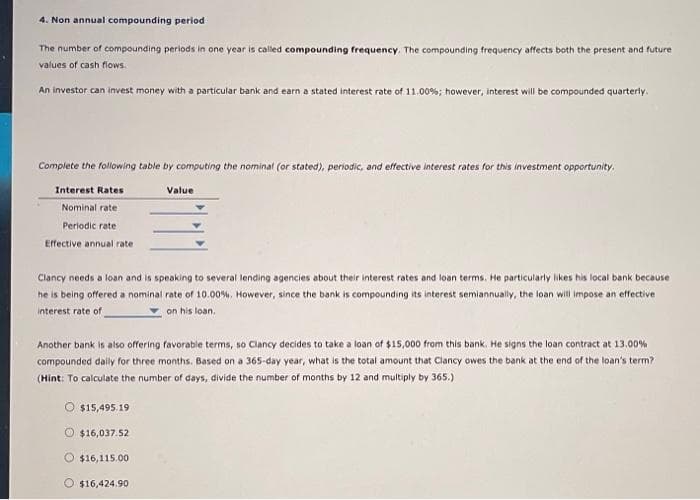4. Non annual compounding period The number of compounding periods in one year is called compounding frequency. The compounding frequency affects both the present and future values of cash flows. An investor can invest money with a particular bank and earn a stated interest rate of 11.00%; however, interest will be compounded quarterly. Complete the following table by computing the nominal (or stated), periodic, and effective interest rates for this investment opportunity. Value Interest Rates Nominal rate Periodic rate Effective annual rate Clancy needs a loan and is speaking to several lending agencies about their interest rates and loan terms. He particularly likes his local bank because he is being offered a nominal rate of 10.00%. However, since the bank is compounding its interest semiannually, the loan will impose an effective interest rate of on his loan. Another bank is also offering favorable terms, so Clancy decides to take a loan of $15,000 from this bank. He signs the loan contract at 13.00% compounded daily for three months. Based on a 365-day year, what is the total amount that Clancy owes the bank at the end of the loan's term? (Hint: To calculate the number of days, divide the number of months by 12 and multiply by 365.) $15,495.19 $16,037.52 $16,115.00 $16,424.90
4. Non annual compounding period The number of compounding periods in one year is called compounding frequency. The compounding frequency affects both the present and future values of cash flows. An investor can invest money with a particular bank and earn a stated interest rate of 11.00%; however, interest will be compounded quarterly. Complete the following table by computing the nominal (or stated), periodic, and effective interest rates for this investment opportunity. Value Interest Rates Nominal rate Periodic rate Effective annual rate Clancy needs a loan and is speaking to several lending agencies about their interest rates and loan terms. He particularly likes his local bank because he is being offered a nominal rate of 10.00%. However, since the bank is compounding its interest semiannually, the loan will impose an effective interest rate of on his loan. Another bank is also offering favorable terms, so Clancy decides to take a loan of $15,000 from this bank. He signs the loan contract at 13.00% compounded daily for three months. Based on a 365-day year, what is the total amount that Clancy owes the bank at the end of the loan's term? (Hint: To calculate the number of days, divide the number of months by 12 and multiply by 365.) $15,495.19 $16,037.52 $16,115.00 $16,424.90
Financial Accounting: The Impact on Decision Makers
10th Edition
ISBN:9781305654174
Author:Gary A. Porter, Curtis L. Norton
Publisher:Gary A. Porter, Curtis L. Norton
Chapter9: Current Liabilities, Contingencies, And The Time Value Of Money
Section: Chapter Questions
Problem 9.21MCE
Related questions
Question

Transcribed Image Text:4. Non annual compounding period
The number of compounding periods in one year is called compounding frequency. The compounding frequency affects both the present and future
values of cash flows.
An investor can invest money with a particular bank and earn a stated interest rate of 11.00%; however, interest will be compounded quarterly.
Complete the following table by computing the nominal (or stated), periodic, and effective interest rates for this investment opportunity.
Interest Rates
Nominal rate :
Periodic rate
Effective annual rate
Clancy needs a loan and is speaking to several lending agencies about their interest rates and loan terms. He particularly likes his local bank because
he is being offered a nominal rate of 10.00%. However, since the bank is compounding its interest semiannually, the loan will impose an effective
interest rate of
on his loan.
Another bank is also offering favorable terms, so Clancy decides to take a loan of $15,000 from this bank. He signs the loan contract at 13.00%
compounded daily for three months. Based on a 365-day year, what is the total amount that Clancy owes the bank at the end of the loan's term?
(Hint: To calculate the number of days, divide the number of months by 12 and multiply by 365.)
O $15,495.19
Ⓒ$16,037.52
Value
$16,115.00
O $16,424.90
Expert Solution
This question has been solved!
Explore an expertly crafted, step-by-step solution for a thorough understanding of key concepts.
This is a popular solution!
Trending now
This is a popular solution!
Step by step
Solved in 4 steps with 4 images

Knowledge Booster
Learn more about
Need a deep-dive on the concept behind this application? Look no further. Learn more about this topic, finance and related others by exploring similar questions and additional content below.Recommended textbooks for you

Financial Accounting: The Impact on Decision Make…
Accounting
ISBN:
9781305654174
Author:
Gary A. Porter, Curtis L. Norton
Publisher:
Cengage Learning


Cornerstones of Financial Accounting
Accounting
ISBN:
9781337690881
Author:
Jay Rich, Jeff Jones
Publisher:
Cengage Learning

Financial Accounting: The Impact on Decision Make…
Accounting
ISBN:
9781305654174
Author:
Gary A. Porter, Curtis L. Norton
Publisher:
Cengage Learning


Cornerstones of Financial Accounting
Accounting
ISBN:
9781337690881
Author:
Jay Rich, Jeff Jones
Publisher:
Cengage Learning

Intermediate Financial Management (MindTap Course…
Finance
ISBN:
9781337395083
Author:
Eugene F. Brigham, Phillip R. Daves
Publisher:
Cengage Learning

EBK CONTEMPORARY FINANCIAL MANAGEMENT
Finance
ISBN:
9781337514835
Author:
MOYER
Publisher:
CENGAGE LEARNING - CONSIGNMENT
